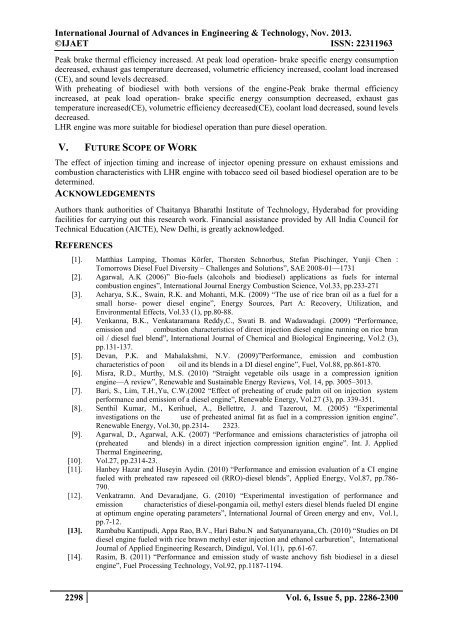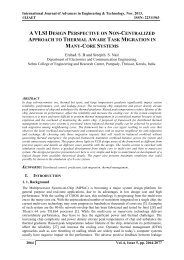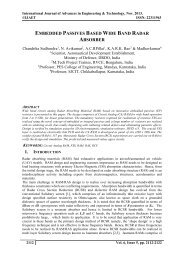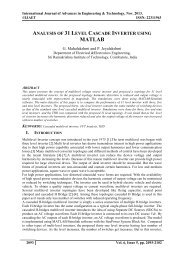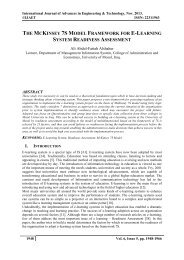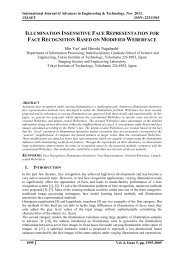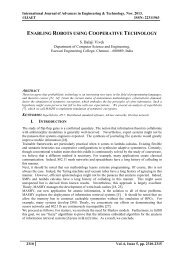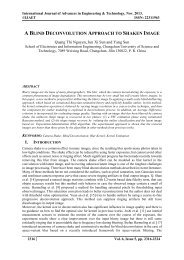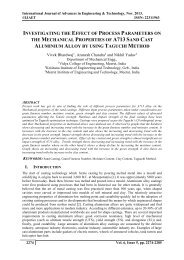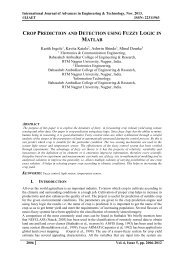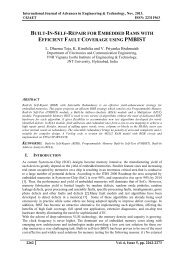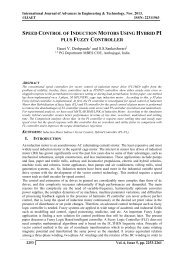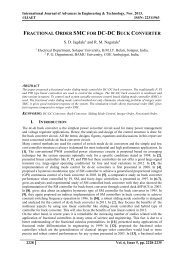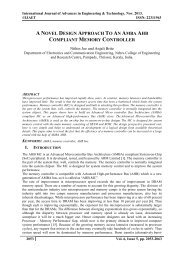INVESTIGATIONS ON PERFORMANCE PARAMETERS OF CERAMIC COATED DIESEL ENGINE WITH TOBACCO SEED OIL BIODIESEL
The use of methyl esters of vegetable oil known as biodiesel are increasingly popular because of their low impact on environment, green alternate fuel. Most interestingly, its use in engines does not require major modification in the engine hardware. Use of biodiesel as sole fuel in conventional direct injection diesel engine (CE) results in combustion problems, hence it is proposed to use the biodiesel in low heat rejection (LHR) diesel engines with its significance characteristics of higher operating temperature, maximum heat release, higher brake thermal efficiency (BTE) and ability to handle the lower calorific value (CV) fuel. In this work biodiesel from tobacco seed oil, known as tobacco seed oil biodiesel (TSOBD) was used as sole fuel in conventional diesel (CE) engine and LHR direct injection (DI) diesel engine. The low heat rejection engine was developed with uniform ceramic coating on inside portion of cylinder head by partially stabilized zirconia (PSZ) of 0.5 mm thickness. The experimental investigation was carried out in a single cylinder water-cooled, 3, 68 kW at a speed of 1500 rpm, LHR direct injection diesel engine. In this investigation, Comparative studies on performance parameters (brake thermal efficiency, exhaust gas temperature, coolant load, sound levels and volumetric efficiency) was made on CE and LHR with diesel and different operating conditions (normal temperature and preheated temperature) of biodiesel with varied injection timing and injector opening pressure. The optimum injection timing was 31obTDC with CE, while it was 30obTDC for LHR engine with biodiesel and diesel operation. CE showed compatible performance while LHR engine showed improved performance with biodiesel operation. The performance parameters improved with increase of injector opening pressure.
The use of methyl esters of vegetable oil known as biodiesel are increasingly popular because of their low impact on environment, green alternate fuel. Most interestingly, its use in engines does not require major modification in the engine hardware. Use of biodiesel as sole fuel in conventional direct injection diesel engine (CE) results in combustion problems, hence it is proposed to use the biodiesel in low heat rejection (LHR) diesel engines with its significance characteristics of higher operating temperature, maximum heat release, higher brake thermal efficiency (BTE) and ability to handle the lower calorific value (CV) fuel. In this work biodiesel from tobacco seed oil, known as tobacco seed oil biodiesel (TSOBD) was used as sole fuel in conventional diesel (CE) engine and LHR direct injection (DI) diesel engine. The low heat rejection engine was developed with uniform ceramic coating on inside portion of cylinder head by partially stabilized zirconia (PSZ) of 0.5 mm thickness. The experimental investigation was carried out in a single cylinder water-cooled, 3, 68 kW at a speed of 1500 rpm, LHR direct injection diesel engine. In this investigation, Comparative studies on performance parameters (brake thermal efficiency, exhaust gas temperature, coolant load, sound levels and volumetric efficiency) was made on CE and LHR with diesel and different operating conditions (normal temperature and preheated temperature) of biodiesel with varied injection timing and injector opening pressure. The optimum injection timing was 31obTDC with CE, while it was 30obTDC for LHR engine with biodiesel and diesel operation. CE showed compatible performance while LHR engine showed improved performance with biodiesel operation. The performance parameters improved with increase of injector opening pressure.
You also want an ePaper? Increase the reach of your titles
YUMPU automatically turns print PDFs into web optimized ePapers that Google loves.
International Journal of Advances in Engineering & Technology, Nov. 2013.<br />
©IJAET ISSN: 22311963<br />
Peak brake thermal efficiency increased. At peak load operation- brake specific energy consumption<br />
decreased, exhaust gas temperature decreased, volumetric efficiency increased, coolant load increased<br />
(CE), and sound levels decreased.<br />
With preheating of biodiesel with both versions of the engine-Peak brake thermal efficiency<br />
increased, at peak load operation- brake specific energy consumption decreased, exhaust gas<br />
temperature increased(CE), volumetric efficiency decreased(CE), coolant load decreased, sound levels<br />
decreased.<br />
LHR engine was more suitable for biodiesel operation than pure diesel operation.<br />
V. FUTURE SCOPE <strong>OF</strong> WORK<br />
The effect of injection timing and increase of injector opening pressure on exhaust emissions and<br />
combustion characteristics with LHR engine with tobacco seed oil based biodiesel operation are to be<br />
determined.<br />
ACKNOWLEDGEMENTS<br />
Authors thank authorities of Chaitanya Bharathi Institute of Technology, Hyderabad for providing<br />
facilities for carrying out this research work. Financial assistance provided by All India Council for<br />
Technical Education (AICTE), New Delhi, is greatly acknowledged.<br />
REFERENCES<br />
[1]. Matthias Lamping, Thomas Körfer, Thorsten Schnorbus, Stefan Pischinger, Yunji Chen :<br />
Tomorrows Diesel Fuel Diversity – Challenges and Solutions”, SAE 2008-01—1731<br />
[2]. Agarwal, A.K (2006)” Bio-fuels (alcohols and biodiesel) applications as fuels for internal<br />
combustion engines”, International Journal Energy Combustion Science, Vol.33, pp.233-271<br />
[3]. Acharya, S.K., Swain, R.K. and Mohanti, M.K. (2009) “The use of rice bran oil as a fuel for a<br />
small horse- power diesel engine”, Energy Sources, Part A: Recovery, Utilization, and<br />
Environmental Effects, Vol.33 (1), pp.80-88.<br />
[4]. Venkanna, B.K., Venkataramana Reddy,C., Swati B. and Wadawadagi. (2009) “Performance,<br />
emission and combustion characteristics of direct injection diesel engine running on rice bran<br />
oil / diesel fuel blend”, International Journal of Chemical and Biological Engineering, Vol.2 (3),<br />
pp.131-137.<br />
[5]. Devan, P.K. and Mahalakshmi, N.V. (2009)”Performance, emission and combustion<br />
characteristics of poon oil and its blends in a DI diesel engine”, Fuel, Vol.88, pp.861-870.<br />
[6]. Misra, R.D., Murthy, M.S. (2010) “Straight vegetable oils usage in a compression ignition<br />
engine—A review”, Renewable and Sustainable Energy Reviews, Vol. 14, pp. 3005–3013.<br />
[7]. Bari, S., Lim, T.H.,Yu, C.W.(2002 “Effect of preheating of crude palm oil on injection system<br />
performance and emission of a diesel engine”, Renewable Energy, Vol.27 (3), pp. 339-351.<br />
[8]. Senthil Kumar, M., Kerihuel, A., Bellettre, J. and Tazerout, M. (2005) “Experimental<br />
investigations on the use of preheated animal fat as fuel in a compression ignition engine”.<br />
Renewable Energy, Vol.30, pp.2314- 2323.<br />
[9]. Agarwal, D., Agarwal, A.K. (2007) “Performance and emissions characteristics of jatropha oil<br />
(preheated and blends) in a direct injection compression ignition engine”. Int. J. Applied<br />
Thermal Engineering,<br />
[10]. Vol.27, pp.2314-23.<br />
[11]. Hanbey Hazar and Huseyin Aydin. (2010) “Performance and emission evaluation of a CI engine<br />
fueled with preheated raw rapeseed oil (RRO)-diesel blends”, Applied Energy, Vol.87, pp.786-<br />
790.<br />
[12]. Venkatramn. And Devaradjane, G. (2010) “Experimental investigation of performance and<br />
emission characteristics of diesel-pongamia oil, methyl esters diesel blends fueled DI engine<br />
at optimum engine operating parameters”, International Journal of Green energy and env, Vol.1,<br />
pp.7-12.<br />
[13]. Rambabu Kantipudi, Appa Rao, B.V., Hari Babu.N and Satyanarayana,.Ch. (2010) “Studies on DI<br />
diesel engine fueled with rice brawn methyl ester injection and ethanol carburetion”, International<br />
Journal of Applied Engineering Research, Dindigul, Vol.1(1), pp.61-67.<br />
[14]. Rasim, B. (2011) “Performance and emission study of waste anchovy fish biodiesel in a diesel<br />
engine”, Fuel Processing Technology, Vol.92, pp.1187-1194.<br />
2298 Vol. 6, Issue 5, pp. 2286-2300


